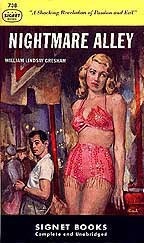Ed Gorman's Blog, page 159
May 27, 2012
Gravetapping; Wilson Tucker
Ed Gorman: Welcome back to posting, Ben Boulden. Today he posted about both Jack Bickham and Bill Pronzini. Bill is of course one of the finest crime fiction writers in the world and is in fact an mwa grandmaster. Ben reviews one of bill's most compelling and darkest novels nightcrawlers. jack was lesser known but extremely talented. ben discusses the night hunters, my favorite bickham novel.i liked it so much after reading it in pb i bought a hardcover and sent it to jack for an autograph. we started corresponding after that. he fought hard aganst the cancer that kept coming back, writing and teaching (he was one of the best) while battling it. A damned fine man and writer.bill and jack both wrote for the bobbs-merlll line that ben discusses in the same post. good stuff. Amazing what came out of that line, including the firt Fketch novel. Zilch for a budget unfortunately. MONDAY, MAY 27, 2012
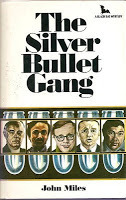 Bobbs-Merrill EditionIn the early- to mid-1970s Bobbs-Merrill, as part of its Black Bat Mystery line, published four early suspense novels written by Jack M. Bickham. The four titles were published as by “John Miles”, a pseudonym Mr Bickham used primarily for his early crime and suspense novels, and later for his whodunits. The publication of the Black Bat Mystery titles was a landmark in his career. It represented the change of Bickham’s writing focus from westerns to mystery and suspense.
Bobbs-Merrill EditionIn the early- to mid-1970s Bobbs-Merrill, as part of its Black Bat Mystery line, published four early suspense novels written by Jack M. Bickham. The four titles were published as by “John Miles”, a pseudonym Mr Bickham used primarily for his early crime and suspense novels, and later for his whodunits. The publication of the Black Bat Mystery titles was a landmark in his career. It represented the change of Bickham’s writing focus from westerns to mystery and suspense.The John Miles nom de plume was first used by Bickham on his nifty little 1961 crime novel Dally with a Deadly Doll (Ace, D-489). Over the next decade he used the Miles brand sparingly, choosing instead to write westerns under his own name and as by “Jeff Clinton”. The titles published with the Clinton moniker featured a brawling red-headed series character named Wildcat O’Shea. He later published a handful of non series westerns under the pseudonym, and a single science fiction novel titled Kane’s Odyssey (1976).
for the rest go here:gravetapping.blogspot.com/
-----------------------------------------------Wilson Tucker, Rog Ebert, Vic Ryan and me
Ed here: Somebody sent me this paragraph from a piece about the late Wilson Tucker who was both a prominent writer and fan in science fiction circles for many decades. The Long Loud Silence is still one of my all-time favorite sf novels and I enjoyed his mysteries almost as much as his science fiction. The bit here refers to the time Ebert, Ryan and I attended our first sf convention thanks to Tucker, who drove us to Cincinatti from his home in Bloomington, Illinois. He was pure gentleman.
"At Tucker's 88th birthday party held in Bloomington, Illinois, I heard a fan ask Bob why he had stopped writing. Without hesitation, Tucker said, "Because I'm no longer driven." But he was still very much a social person, still seeking human contact and holding out hope of finding one more mind to help in some way. I didn't ask him why he was still doing this...for the answer would have been, "Because there's nothing else for me to do." I attended because I knew it would be the last time I would see him. At one point, we were interrupted by someone wanting him to go elsewhere, Tucker smiled at them politely and said, "No, I want to talk to George." I reminded him of the time, in 1961 I think it was, when he attended the MidWestCon, bringing with him three young men...Ed Gorman, Vic Ryan, and Roger Ebert. Tucker had the most pleased look on his face when he introduced them and turned them loose...sort of like 'Let's see you draw to three of these.'
May 26, 2012
Ralph Dennis

RALPH DENNIS
from 2006
Ralph Dennis
Tommorrow night I'm going to run a piece by the writer Richard A. Moore on the subject of the most beloved obscure private eye writer who ever lived, that being Ralph Dennis who published eleven novels in his Hardman series in the early 1970s.
The books are short enough that I was able to read two of them last night preparing for this entry. The story goes, and the story is wrong, that maybe just maybe Robert B. Parker read one these got his idea for a white p.i. with a black superdude buddy. That is the one similarity the two series share and it's not much of a similarity at all. To me, on a lesser level, the mixed race buddies go back to at least The Lone Ranger.
Where Parker is resolutely BWM and upscale, Dennis is resolutely blue collar (or below). Both men prefer the worlds of their invention to the worlds most of us would call reality. Both the are very good at giving the patina of reality to their respective worlds but their wise enough not to give us naturalism in their books. Chandler was very real either.
Dennis coulda been a contender. His was a narrower fix on the p.i. field than Parker's but if he'd lived longer that might have changed. Parker is a great mass entertainer. A true and enduring star. I'm not sure that Dennis, or most of us, have that quaity in us. That's not to lessen Dennis' achievements, which are considerable. It's just that he never takes us anywhere different. He pretty much lives on the mean streets with down and outers. Parker takes on life in pro sports, life on a college faculty, life on tracking a serial killer. He's like great and classic boxer. He knows enough to keep moving.
Richard Moore is a fine writer in his own right and brings all his gifts to this intriguing piece on the sad life of another fine writer, Ralph Dennis.
May 25, 2012
Richard Braughtigan
 Ed here: I was never a major Richard Brautigan fan. While I liked Trout Fishing and a good share of his pieces in Rolling Stone, there was always a little too much flower power in his material for me. I remember that when he died I wrote along letter about him to a friend of mine the point of which being that some signal people in our generation's narcissistic yearning for celebration were passing on and that good old days of dope dope dope and free love and the bizarre notion that we could run things more honorably than our parents had...Well, that hadn't worked out so well had it. Good with the bad but looking back there was an awful lot of bad and silly bad manic bad maniac bad and Brautigan was sadly a part of it all.As were a lot of us. I have to say that William Hjortsberg is one of the most interesting writers on the planet.In Pursuit of Pleasure and TroutBy DWIGHT GARNER
Ed here: I was never a major Richard Brautigan fan. While I liked Trout Fishing and a good share of his pieces in Rolling Stone, there was always a little too much flower power in his material for me. I remember that when he died I wrote along letter about him to a friend of mine the point of which being that some signal people in our generation's narcissistic yearning for celebration were passing on and that good old days of dope dope dope and free love and the bizarre notion that we could run things more honorably than our parents had...Well, that hadn't worked out so well had it. Good with the bad but looking back there was an awful lot of bad and silly bad manic bad maniac bad and Brautigan was sadly a part of it all.As were a lot of us. I have to say that William Hjortsberg is one of the most interesting writers on the planet.In Pursuit of Pleasure and TroutBy DWIGHT GARNERJUBILEE HITCHHIKER
The Life and Times of Richard Brautigan
By William Hjortsberg
Illustrated. 852 pages. Counterpoint. $42.50.
For a committed sensualist and prototypical hippie, a man who wore floppy hats, granny glasses, love beads and a droopy mustache that made him look like General Custer at an acid test, Richard Brautigan (1935-1984) had a potent work ethic.
He wrote nearly every morning, regardless of keening hangovers. He spent the rest of the day, William Hjortsberg notes in “Jubilee Hitchhiker,” his sprawling and definitive new biography of this most offbeat of American writers, “in pursuit of happiness.” Happiness for Brautigan usually meant, to borrow the title of an undervalued W. M. Spackman novel, an armful of warm girl. In San Francisco, where he mostly lived, and elsewhere, he had groupies and would hit on “anything that wasn’t nailed down,” one friend commented. He put some of his favorite bohemian cuties on the front of his books. “Richard’s sexual archive,” another friend said, “is reflected on his book covers.” Happiness meant seeing plenty of movies. Once he began making money, in the early 1970s, it also meant good food (oysters, pork buns, the most expensive lobsters at The Palm steakhouse) and guns, which, when drunk, he would frequently discharge indoors. Brautigan and the film director Sam Peckinpah, a friend, once opened fire with a .357 Magnum and a .38 Colt at an alley cat through an open hotel room window.
Brautigan’s signal pleasure, though, from the time he was a young boy, growing up poor in a broken family in Tacoma, Wash., until the end of his life, was trout fishing. It was an obsession that fed his first and probably best novel, “Trout Fishing in America,” written in 1961 but not issued by a major publishing house until 1969.
Generations of anglers have picked up “Trout Fishing in America” based on its title alone, expecting a how-to volume. What they get instead is akin to a gentle tab of LSD: an eccentric and slyly profound novel, seemingly narrated by the ghost of trout fishing past and filled with surreal post-“Walden” visions like a dismembered trout stream for sale at a junkyard.
Brautigan wrote his best novels — “Trout Fishing in America,” “A Confederate General From Big Sur” (1964), “In Watermelon Sugar” (1968) and “The Abortion” (1971) — and books of poetry, notably “The Pill Versus the Springhill Mine Disaster” (1968) before fame swamped him in the early ’70s, when he was in his mid-to-late 30s.
He got rich suddenly and enjoyed himself vastly. His writing got woolier and worse, however, and the critics turned on him. He spent most of the money. His looks began to go. (One of his best-known poems is titled “My Nose Is Growing Old.”) Neurotic and increasingly in debt, he committed suicide with a handgun in 1984, at 49.
For the rest go here: http://www.nytimes.com/2012/05/23/boo...
May 24, 2012
Forgotten Books:1001 Midnights edited by Bill Pronzini and Marcia Muller

For what to me are obvious reasons I've never been a particular fan of the famous Jacques Barzun mystery list. I find his writing pedantic and his selection of books sometimes questionable. I'm sorry--it's just the reaction I've always had to it. I'll take H.R.F. Keating's 100 Mystery novels any day.
So I've had to look elsewhere for lists to help rubes like me find treasures I'd never come across otherwise. My favorite book is 1001 Midnights edited by Bill Pronzini and Marcia Muller. I've read at least forty of the novels recommended in this massive compendium. And sometimes for pleasure I just pick it up to read it.
Every genre is covered here. So are writers great and small. And who are some of the reviewers recommending books? How about Max Collins, Crider, George Kelly, John Lutz, Barry Malzberg, Robert Randisi, Art Scott and Julie Smith? Among many, many others including the Mulzinis themselves. (I have two reviews in here myself.) You can share the pleasure they have in touting overlooked books. And in a few cases downgrading a book that was so fashionable a few decades back.
God I love this book and you will too.
May 23, 2012
Me Tarzan You Nobody
Ed here: And I dom't care what anybody says-John Carter of Mars was a great movie. Absolutely true to Burroughs.WEDNESDAY, FEBRUARY 14, 2007
One of the Carter pieces mentioned his affection for Edgar Rice Burroughs. I logged on and am glad I did. Burroughs has always fascinated me and I'm not sure why. Maybe because as a young man he was rather pretentious and vainglorious about himself while all the while being a failure at everything he tried. We've all known people like that (I was certainly one fo them myself--Brian Moore's great The Luck of Ginjer Coffee gets him down on paper for all time) and while we might snicker at them we know there's something sad about them, too, that the bragging is empty and recognizing themselves in the morning mirror is painful.
Then he became a writer. Sort of just like that. An idiotic turn in a sappy Hwood movie. Then he became a writer. And by God not just any writer. Early on he created Tarzan, books still in print in virtually every country today, nearly one hundred years after their first appearance. I still read two or three Burroughs novels a year. He's not anywhere as good as Rafael Sabatini; and it's sacreligious to even utter the names Robert Louis Stevenson and H. Rider Haggard in the same piece. But I recently reread the first Tarzan novel and think I found the obvious reason for Burroughs' enduring success. He wrote books for innocents. He didn't know a damned thing about Africa, his prose occasonally makes you want to give the book in your hand a hot foot, and nobody will ever be outdone in his hatred of Germans (I ain't crazy about them either but still).
But in his innocence he allowed himself to create human creatures who have virtually no human responses. Swinging through the trees in a loincloth? Jane giving it all up to leave in a tree house? Apes and lions living in terror of this white dude? An "Africa" that bears no relation whatsoever to the real thing, an Africa in fact that's closer to the Burroughs Mars than any place else?
When you talk about the aventure novels scooped up by boys early in the last century you ARE talking about Stevenson and Haggard and Sabatini. But for all their adventurousness each of their books come with serious themses. Haggard's She remains nothing less than a bitter look at the mortality of our our species; a very dark book at its core. Sabatini's novels are implicit condemnations of imperialsim and expansionism. And the underlying psychology of Stevenson's bad guys invariably alter the lives of their young victims forever. Consider Treasure island, for instance, in juxtaposition to The Treasure of Sierra Madre. In some ways they're identical. And yet the Stevenson is a young adult book.
But it's fun sometimes to escape all that with Edgar Rice Burroughs. One of my favorite images in all literature is John Carter in that Arizona cave deep in the night when he's summoned to Mars. It's one of the most eerily beautiful scenes I've ever read.
May 22, 2012
'Route 66,' the complete series, now on DVD
 By Chris Ball, The Plain Dealer
By Chris Ball, The Plain Dealer 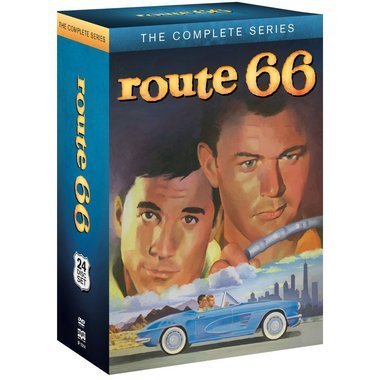 View full size
View full size"Route 66," the complete series
Two clean-cut young men drift across the country in a Corvette convertible, looking for odd jobs and finding adventure in this classic CBS drama.
You can feel the influence of Jack Kerouac's "On the Road" in the 1960-64 series, but its heroes certainly aren't bongo-playing beatniks. The decent, capable characters are quick to lend a hand to a stranger in need as they journey from town to town and coast to coast.
Martin Milner, who later starred in "Adam-12," is on board as Tod Stiles for all 116 episodes. His traveling companion for the first 82 episodes is George Maharis as Buz Murdock. When an illness sidelines Maharis, he is replaced for the final 32 episodes by Glenn Corbett as Lincoln Case.
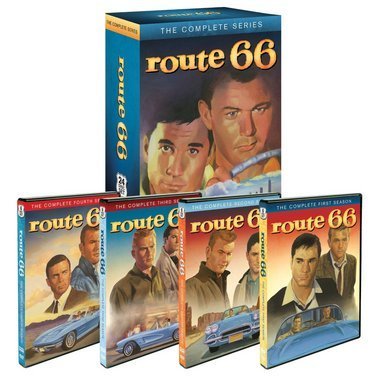 View full size
View full sizePart of the show's appeal lies in its constantly changing setting. One of the associate producers, Sam Manners, was born in Cleveland, and thus a number of episodes take place in prominent Northeast Ohio locations. They include Edgewater Park, the Flats, the port, the East Ninth Street pier, Public Square, a Bratenahl mansion, Euclid Beach Amusement Park and the construction of the freeway interchange at Mayfield Road and I-271.
Most of the episodes were penned by writer-producer Stirling Silliphant, an Oscar winner for his screenplay for "In the Heat of the Night."
Nelson Riddle composed and performed the show's instrumental theme song, which became a pop hit. Arthur Hiller ("Love Story") directed 12 episodes.
Guest stars include Lee Marvin, Inger Stevens, Robert Duvall, Robert Redford, Rod Steiger, Jack Warden, Ed Asner, Michael Rennie, Julie Newmar, Tammy Grimes, Herschel Bernardi, Barbara Eden, Tom Bosley, DeForest Kelley, John Astin, Harvey Korman, Sylvia Miles, Leslie Nielsen, Burt Reynolds, Ron Howard, Gene Hackman, Martin Sheen, James Caan, Buster Keaton, Peter Lorre, Anne Francis and Suzanne Pleshette.
Unlike many TV shows that eventually just fade out, "Route 66" had a definite concluding episode, where one character gets married and another makes plans to return home to his family.
"Route 66" first arrived on DVD with season one, volume one in 2007, followed little by little by the remainder of the first three seasons. Season four has not been released separately and is only now making its DVD debut in this complete series, prompting complaints from fans who already own the first three seasons and only need the fourth.
The complete series is 24 discs, covering 100 hours. DVD extras consist of vintage commercials, a historical featurette on the Corvette, and the only new bonus item, a 1990 panel discussion at the William S. Paley Television Festival, with Maharis, Hiller, writer-producer Herbert B. Leonard and casting director Marion Dougherty.
From Shout Factory. Released May 22.
cball@plaind.com
May 21, 2012
The Urban Landscape of Marxist Noir Alan Wald
FROM CRIME TIME
(Thanks to Terry Butler for the link)
Professor Alan Wald tells Graham Barnfield about the writers rediscovered after years of forensic detective work
Part of your last book Writing from the Left reads as a pledge to rediscover the lost authors of the 1940s and 1950s. How did you become interested in these writers?
My preoccupation with 'lost' leftwing authors of the 1940s and 1950s is a logical extension of my research on the 'committed' radical writers of the 1930s. Many of the best-known 'left' authors of the Depression era were, in fact, formed as writers and intellectuals in the 1920s - for example, John Dos Passos, James T. Farrell, Josephine Herbst, and Langston Hughes. Even Michael Gold and Jack Conroy served literary apprenticeships in the 1920s. This explains why I was particularly concerned in my first three books with the relationship of Marxism to Modernism, since 'High Modernism' was in full swing in the 1920s. But it wasn't very long before I was asking myself: what was the trajectory of those who were very young in the 1930s, who perhaps did not reach their stride until after World War Two? I was also struck by the fact that so many of the 'canonised' texts of 1930s, such as The Grapes of Wrath, For Whom the Bell Tolls, U.S.A., Native Son, the Studs Lonigan trilogy, Waiting for Lefty, were by writers who later repudiated the particular kind of radicalism to which they adhered at the time when they produced their masterpieces. So I also began to ask myself about the cultural production - and the lives - of those who stayed true to their early convictions through the years of McCarthyite persecution. As a result of further research I began to wonder if it might be an inaccurate representation of US cultural history to focus so much on a '1930s' or 'Great Depression' radical tradition organised around a paradigm of strike novels, conversions-to-Communism novels, and so on. Would it not be more appropriate to think about a radical tradition of larger scope that perhaps expressed itself in distinct forms - and achieved its greatest notoriety - during the 1930s? What if the left tradition were more central to US culture, rather than episodic to 'protest decades' like the 1930s and 1960s? And what if 'writers on the left' were redefined to mean 'writings by leftists', regardless of genre? So I began looking at the names that I did NOT recognise in the book review sections of left publications, or from the membership lists of left cultural organisations. In particular, when I could not locate any references to them in standard literary histories and reference books, I became even more intrigued. I used 'detective' methods of trying to find out the fate of these people - rummaging through phone books in various cities, going to the physical locations of some of their books, writing personal letters to their last known addresses, and looking in the 'miscellaneous' files of the archives of the more important writers and political figures (where materials from unidentified people tends to get lumped and then overlooked). As it turned out, a surprising number of such writers were - or soon became - involved in crime/thriller/pulp/mystery writing, often marked in some fashion by the encounter with Marxism.
for the rest go here:
http://www.crimetime.co.uk/features/marxistnoir.html
May 20, 2012
LeeMarvin in "The Killers" by Fred Blosser
 SUNDAY, MAY 13, 2007From Fred BlosserEd, there was a fine essay by Manohla Dargis about Lee Marvin in "The New York Times" on Friday -- a must-read if you haven't seen it.
SUNDAY, MAY 13, 2007From Fred BlosserEd, there was a fine essay by Manohla Dargis about Lee Marvin in "The New York Times" on Friday -- a must-read if you haven't seen it.The article's comments about Marvin's performance in Don Siegel's "The Killers" prompted me to pull out my video copy and watch it again for the first time in several years. As I remembered, it's a great crime film with an amazing cast and a tight-knit Gene L. Coon script wonderfully directed by Siegel. Except for some ancient production techniques, such as back projection and some rather blatant stock footage in a few scenes, it hardly seems dated at all. While Dargis remarks that Marvin "owns the film up, down and sideways," the rest of the cast ain't shabby either -- John Cassavettes, Ronald Reagan, Angie Dickinson, Claude Akins, Norman Fell, and Clu Gulager.
You know, the critics in the '60s fell all over themselves praising Jean Luc-Godard and Francois Truffaut for "reinventing" the pulp noir story by using the genre as a coat-rack for exisential musings, but "The Killers" goes them one better, in my opinion. It works equally well as a standard gangster thriller and as an existential statement. The movie, as you'll recall, is centered on a quest by Marvin's character, a contract killer, to find out WHY: Why did his latest victim (Cassavettes) face death willingly and resignedly, without running or pleading? Seems to me there are two existential scenarios there. One is the mystery of the victim's seemingly inexplicable acceptance of a premature and violent death. The other is the mystery of why it matters to Marvin's character. Logically, there is no reason for Marvin's character to care at all, but his irrational obsession drives the movie in its irrationality.
The last time I watched the film, back in the '90s, I was most struck by the casting and how, from the vantage point of 30 years on, it was amusing to see that the mail-car heist that lay behind the death of Cassavettes' character was engineered by a future President of the United States and by an actor who may be best remembered today, thanks to TV Land reruns, as comically irascible landlord Stanley Roper in "Three's Company."
Now, nine years on, I am equally struck by the look of Marvin's and Gulager's hit men with their sunglasses and bland business suits. I couldn't have predicted it in 1998, but the sunglasses and bland-suit look would come back big time as a model of sinister cool in the Matrix movies. The sunglasses in "The Killers" come into play in the first scene of the movie, where the gunmen invade a school for the blind to find their victim. (Pretty chilling and prescient image when you come to think of it, in hindsight of the shootings on the campuses of Columbine, Virginia Tech, and other schools.) Presumably, Marvin and Gulager wear shades as a sort of camouflage, in order not to arouse suspicion as outsiders mingling with the blind residents and employees of the school who also wear dark glasses. Later, Gulager continues to wear his dark glasses in inappropriate situations, a touch that reinforces his character's odd, unpredictable, unsettling vibe.
Hm, maybe Dargis is correct in saying that Marvin "owns the movie," but Gulager gives him a good run for the money. (With some thanks to Siegel, according to Stuart Kaminsky's 1974 book on Siegel's movies, which claims that Gulager's "wild role [was] created entirely by Siegel.") My brother-in-law refers to the Method acting by Gulager, Michael Parks, and others in the early '60s as "the slouch and mumble school of acting," but as delivered by Gulager, it hits the precisely right note to distinguish Gulager's younger killer from Marvin's business-like, straight-on character.
The opening scene also features the most brutally unsettling bit of violence in the movie, to my mind, when Marvin and Gulager hit and terrorize a blind secretary (Virginia Christine) who greets them in a friendly way when they walk into her office to ask the whereabouts of the man they have come to find. Nowadays, NOW would probably picket a movie featuring a scene like that, and in principle, I would agree with their outrage, and I suspect Siegel would have too; but I don't see a sexual/misogynistic undertone to the act that often characterizes violence against women in the movies. It is simply a display of force against an innocent person who happens to be a woman, exerted because Marvin and Gulager are inherently if dispassionately violent men who need to locate their target and complete their job as quickly as possible. It sets the tone of the film in the most disturbingly effective way imaginable.
In the Times article, Dargis laments: "For younger audiences, especially those who believe film history starts with Steven Spielberg and George Lucas, Marvin may well represent a question mark. (“Who?” a young friend asked.)" Don Siegel, too, I imagine. But I suspect that today's kids and 20-somethings weaned on extreme video games and Quentin Tarantino would find something familiar and resonant in "The Killers" and in Lee Marvin's performance. What do you think?
Fred Blosser
May 19, 2012
Ghosting
Nobody will ever know. Well, almost nobody.
This is not a new process. It may well have gone on back in Shakespeare's time.
I bring this up because I admire a novel by Leigh Brackett called STRANGER AT HOME. I've been assured she didn't write it. I also admire a novel by Henry Kuttner called MAN DROWNING. Apparently it's an open secret that Cleve Cartmill wrote it.
I guess I have to accept this scuttlebutt as fact. But I wonder. Brackett's style--that sweeping almost mythic prose--is very much in evidence in Stranger. I grew up reading her. I know from Leigh Brackett. I find it difficult to believe that she didn't at least go through somebody else's first draft and make it her own.
As for the Kuttner, a man I admire as much as I admire Brackett, if Drowning is actually by Cleve Cartmill then Cartmill was suicidal when he wrote it. I also know from Cartmill. I can't recall a single Cartmill novel that displays this sense of loss and despair. Despite the fact that Harpers published this in hardcover, this is very much a true Gold Medal novel. And the grotesque woman who hires the protagonist is right out of Kuttner. Not Cartmill. Did Cartmill do the first draft and Kuttner the polish?
See the trouble you get into when you try to fool people?
May 18, 2012
MGM GREENLIGHTS "CARRIE" REMAKE
MGM GREENLIGHTS "CARRIE" REMAKE; KIMBERLY PEIRCE TO DIRECT
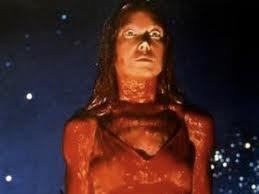
Struggling MGM is betting on the past in order to reverse its fortunes. The studio has a remake of the 1976 filmCarrie going into production. Brian De Palma directed the original adaptation of Stephen King's best-seller about a bullied high school girl who uses psychic powers to get revenge on her tormentors. Sissy Spacek and Piper Laurie earned Oscar nominations for their performances as Carrie and her crazed mother and young John Travolta had an early big screen role in the film. The new version has a female director, Kimberly Peirce. The story line was an early plea against bullying, something that will probably resonate even more today.
Ed Gorman's Blog
- Ed Gorman's profile
- 118 followers


